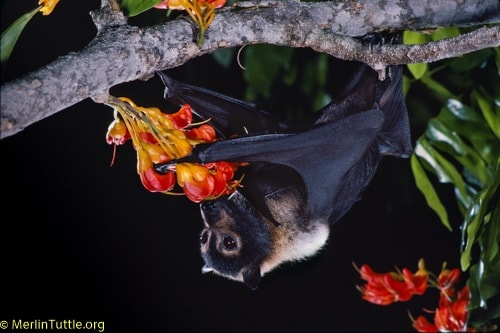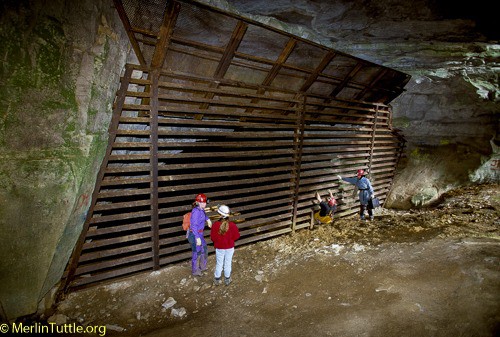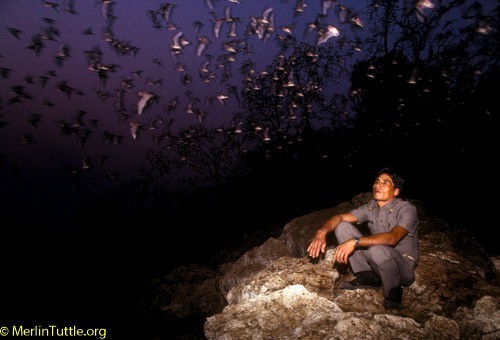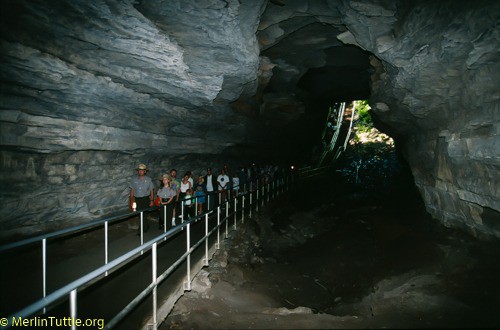Challenging torrential rains countered by cooperative bats in Costa Rica
Merlin and MTBC team members spent 19 days in Costa Rica last November on a filming trip for “Bat City” with its Director and Emmy
There is now unequivocal evidence that climate change and associated weather extremes are accelerating at unprecedented rates due to human activities. (1) (2) (3) At the UN Climate Summit in December 2018, Sir David Attenborough warned that “If we don’t take action, the collapse of our civilizations and the extinction of much of the natural world is on the horizon.” (4)
Mass die-offs of bats and other animals are early warnings of serious environmental stress. In fact, bats are especially relevant indicators. They form the largest, most vulnerable aggregations of any mammal except Homo sapiens, have similarly wide distribution, complex biotic and abiotic requirements, and traditional ecosystem dominance. Many are exceptionally long-lived and occupy high trophic levels. Yet, their importance and plight have long been neglected. (5)
Too often, conservation has been a glamour contest, favoring only the most attractive or most popular plants and animals. However, viewpoints are changing. Once reviled predators, such as hawks and wolves, are now increasingly understood and protected as essential guardians of nature’s balance.
Though clearly challenging in today’s climate of misleading news, bats too can be rescued. No group of animals has a better record of living safely with humans or plays a more important role in protecting biodiversity. (6)

The future isn’t without hope. There are examples of dramatic success, even for bats. The cave-dwelling gray myotis (Myotis grisescens), recipient of my first conservation efforts in the 1970s, was in such precipitous decline that its extinction had been predicted. (7) Yet today, we’ve restored millions. (8) (9)
In the early 1980s, 1.5 million Brazilian free-tailed bats (Tadarida brasiliensis) were the focus of planned extermination efforts by fearful citizens of Austin, Texas who’d been warned that the bats were mostly rabid. Through simple education the bats were saved and have never harmed anyone. Today they consume tons of insect pests nightly and garner 10 million tourist dollars annually. (10)
In 1981, I convinced the monks who owned Khao Chong Phran Cave in Thailand that hiring game wardens to restore their formerly multi-million colony of Asian wrinkle-lipped bats (Chaerephon plicatus) would pay big dividends. (9) As a direct result, the bats have recovered and today annually produce guano fertilizer valued at $135,000 (U.S.) (11) and save local rice farmers a conservatively estimated $300,000 (U.S.) in avoided pest damage. (12) The bats also benefit the local economy by attracting thousands of tourists.
In the early 1980s, due to grossly exaggerated rabies warnings, Americans were spending millions of dollars annually to have bats in buildings poisoned. Today, thousands of homeowners are attracting bats to backyard bat houses (6), and state highway departments have designed bat-friendly bridges that shelter millions of bats. (13) As people learn the truth about bats, the potential for conservation is enormous. The benefits are clear. The bats simply need more ambassadors!

In America, long before the WNS-causing fungus (Pseudogymnoascus destructans) began killing millions of bats, alarming declines were already evident. (14) Today, it is reasonable to hypothesize that long-accumulated stress likely contributed to current vulnerability.

The earliest documented bat declines were due to loss of suitable roosts. Key caves, especially those required for hibernation, were altered for human purposes, (14) (15) and old-growth forests were cleared. (16) (17) Single cave losses left hundreds of thousands, even millions, dead or homeless. (18)
As bats lost roosting cavities in ancient forests, nursery colonies increasingly survived by moving into human structures where countless thousands were eradicated due to needless fear. (6) Many bats attempted to survive loss of their originally large and diverse hibernation caves by taking refuge in smaller caves where they are far less protected from inclement weather and climate change. In regions where abandoned mines were available, some provided ideal refuges. Others became lethal traps when they collapsed or were sealed in safety-closures. (19) (20)
In Australia, flying foxes were once incredibly abundant. As recently as 1930, single flying fox roosts, known as camps, were reported to be up to four miles long by a half-mile wide, including millions of individuals. (21) Many of those camps are gone. And those that remain contain only small fractions of former numbers. (22) (23) (24) (25)
These bats faced two serious threats, loss of forests that once sheltered and fed them, (26) and intense eradication efforts by orchardists. (22) In recent decades substantial progress has been made in educating orchardists to protect crops with netting instead of killing bats. (27) (25)
Nevertheless, tens of thousands of flying foxes are now perishing in single events due to unprecedented heat. (24) They originally formed huge aggregations in taller, primary forest trees along rivers and on islands. These roosts were likely much cooler (28) and provided more options to regulate temperature by moving vertically or in and out of sun versus shade.
As suitable roosting and feeding trees were lost, many flying foxes gradually moved to urban areas. Additionally, as fewer options remained, roost trees became defoliated, providing less protection from sun. (26)(25) Bats were also harassed by homeowners who understandably objected to their noise and droppings. (29) (25) Like some bats in America, Australia’s flying foxes are now dangerously stressed and vulnerable due to a long accumulation of problems.
Left: Bird netting is increasingly used by Australian fruit growers to protect crops from bats, birds, hail and other threats. Middle: Gray-headed flying foxes (Pteropus poliocephalus) exposed unnaturally to sun due to defoliation when too many are forced to share small areas. Right: Some of the eight million straw-colored fruit bats (Eidolon helvum) inhabiting the Kasanka National Park in Zambia. This protected area is too small to accommodate their needs to move to new trees as formerly used ones are gradually defoliated. Large trees have been killed, leaving the bats exposed to sun, unable to find shade during periods of high heat. Such colonies are vital to reforestation across thousands of kilometers, but they are now extremely vulnerable to massive heat stroke kills.
Not surprisingly, bats are exceptionally threatened by climate change. Like us, they form exceptionally large and vulnerable aggregations, rely on multigenerational social structure, and have complex needs. They also rely on sophisticated information sharing from generation to generation. (34) (35) Long-distance travel is often required, as is knowledge of routes, and sometimes the location of difficult-to-find caves and feeding resources. (25) Population collapse can leave potentially lethal gaps in survival knowledge.
Increasing climate change and overall global warming are forecast to be a virtual certainty. And this, combined with climate variability and weather extremes, (1) (36) is likely to render many bat roosts no longer suitable for occupancy, especially those required for winter hibernation. Ideal sites are cold but safe from freezing. And almost invariably the best ones are large and complex. (14)
America’s famous Mammoth Cave provides an ideal example of long accumulating threats to American bats. It traditionally protected bats during weather extremes. Prior to the arrival of European settlers, this cave, by conservative estimate, sheltered over 10 million hibernating bats each winter. Unfortunately, such caves also were the first to attract human use. (18)
When bats were forced to leave, they either died or moved to smaller, less thermally protected caves. These easily became death traps during extreme weather. (14)
Many of today’s survivors are dangerously stressed, leaving them extremely vulnerable to climate change. Severe weather will also destroy older trees most used by bats as nursery sites. Finally, bats may face starvation when fruiting or flowering seasons or insect hatches become too unpredictable to support critical demands for reproduction, migration, or hibernation. (37) (25)
As seen in the currently massive die-offs of Australia’s flying foxes, sudden climate changes, and unpredictable weather, can prove disastrous when added to centuries of environmental neglect.
How much more severity can occur before humans also become threatened? As already seen following hurricanes or typhoons, severe weather can destroy or overburden electrical systems, leaving us defenseless. In addition, droughts and flooding it can cause crop failure and famine. (38) (39) (40) (41)

In attempting to heal nature, we cannot ignore the importance of preservation and restoration of old-growth, sometimes referred to as primary forests. They are extremely complex making them difficult to define. (42) However, they provide “Noah’s Ark-like” refuges for protecting bats and biodiversity in times of climate change. (43) (16)
Such forests are now so rare in industrialized nations that most people have never even seen one. Protection of remaining remnants is critical to preserving our own survival options far beyond restoring bats.
Left: Some of the 250,000 Southeastern myotis (Myotis austroriparius) that were trapped and drowned during a Florida hurricane. Middle: An old-growth forest in British Columbia, Canada. Such forests provide a wide variety of habitat and biodiversity. They also remain approximately 4.5 degrees cooler than mature, previously logged forests. Right: A troglobitic crayfish in an Alabama cave. Bat guano provides the energy for whole cave ecosystems. Countless species rely on bats for their survival.
Industrial-scale forestry and agriculture have already become dangerously dependent on monocultures, i.e. extensive areas of single species grown as crops. These have little natural defense against insect pests, leaving no alternative but to increase use of chemical pesticides that already threaten nearly every aspect of our lives and the natural world that supports us. (44)
Even the microbes from bat guano ecosystems in caves can be important. (15) They may be used to detoxify industrial wastes, improve detergents, or even convert seafood byproducts into gasohol. (45) Protecting caves and old-growth forests for bats is like taking out insurance policies for ourselves.
Current attention is focused on massive losses of bats due to disease and extreme weather. However, it is important to recognize that these likely have been exacerbated by a long accumulation of stress that appears to have begun with habitat loss.
In America, restoration and protection of essential roosts in caves and ancient tree hollows will be crucial to rebuilding lost bat populations. It’s too late to stop the spread of WNS or find a meaningful cure but surviving remnant populations appear capable of rebuilding where suitable habitats are protected and restored. (46) Much can be accomplished at relatively little expense through protection and restoration of roosts, especially those essential for hibernation. Currently marginal sites can be improved. (14) There are numerous opportunities for the public and nature reserves to participate in providing bat houses and other artificial roosts for nursery colonies.
As in America, Australia’s currently massive bat losses are likely a result of long accumulating stress that began with loss of ancient forests that the bats relied on for food and shelter. (25) Today’s kills from unprecedented heat are extremely serious. Solutions likely will require additional education combined with research on roost needs and strategic conservation and restoration of forests. (25)
Worldwide, education is key and urgently needed. People must learn that bats have one of our planet’s finest records of living safely with humans, and that simply left alone, they make invaluable, even fascinating and likable neighbors. Those who care about bats must also help solve problems caused when too many attempt to live in the wrong place and become a nuisance. (25) Until bats are understood and problems solved, they will remain neglected by conservationists, often not tolerated, and even killed by the public. (6)
Counter Fear—People everywhere must be taught to put bat fears versus values in perspective. Humans seldom tolerate and often kill animals they fear regardless of claimed benefits. Bats rarely transmit diseases and are always safer than pesticides!
Become an Ambassador for Nature—Become well-informed and learn to share your knowledge in an entertaining manner, keeping in mind that our goal is protection of the diversity of life, not just our favorite animals.
Provide Homes—Put up a bat house or help restore and protect natural roosts of past importance, especially in caves. Loss or degradation of traditional roosts is often the most important cause of bat decline. Also, in North America, there are excellent cave and abandoned mine restoration opportunities that could provide habitat for hundreds of thousands of endangered bats at minimal cost.
Document Values & Needs—Be careful how and where you invest donations regardless of the cause. Waste is no longer affordable. Also, be sure your taxes are spent wisely on highest priorities, not just on emotion-based actions of the moment. Urge academic institutions to provide better support for work that has long-term relevance in solving real problems that are accurately communicated to the public. If you are a researcher, focus on quality studies that contribute most to knowledge of bat values and needs, or other issues most relevant to protecting nature. Share your findings with the public.
Prioritize—Support activities that will provide the longest-term solutions. In considering which animals, plants, or habitats to save first, always ask which one will have the greatest long-term impact in protecting or restoring ecosystems? Consider prioritizing still abundant, but highly vulnerable species that contribute most to ecosystem health or help restore formerly abundant species whose survival will have greatest impact in helping others.
Encourage Native Vegetation—Wherever possible, protect and restore native vegetation, especially trees that may provide either food or shelter for bats. Exotic and ornamental plants tend to be useless to native insects needed as forage for birds, bats, and other wildlife. Worldwide, deforestation threats (47) to wildlife are extremely serious and projected to increase rapidly. Even scattered trees mixed with agriculture can prove helpful.
Consume Less & Recycle More—Take personal ownership of urgent needs to consume less and recycle more. It’s easy to blame poor countries for overpopulation and waste, However, from an ecological standpoint, we, the privileged few, often cause far greater environmental harm due to our greater consumption and waste. Plastic recycling is urgent. Incentives work better than confrontation.
Support Family Planning—This is a delicate topic, but one that, for the sake of our species, we can no longer ignore. No matter how we rationalize, it can’t be denied that we’ve already exceeded our planet’s ideal carrying capacity. The road to a cleaner, safer planet will be paved by family planning. The false assumption that our economies will fail without endless population growth and consumption may pose the single greatest threat to our future.
Left: Rick Clausen, endangered Indiana myotis recovery team leader, and Jim Kennedy census the first of thousands of endangered Indiana myotis that immediately began returning to their former hibernation area in Saltpetre Cave, Kentucky, following restoration and protection. Middle: Bat houses are achieving high success rates in attracting several species of insect-eating bats and are increasingly popular (Courtesy of Bat Conservation and Management, Inc.) Right: Millions of Asian wrinkle-lipped bats (Chaerephon plicatus) emerging from Khao Chong Phran cave in Thailand following more than 20 years of protection.
Bibliography
Love our content? Support us by sharing it!
Merlin and MTBC team members spent 19 days in Costa Rica last November on a filming trip for “Bat City” with its Director and Emmy
“Just like the old days, eh Heather?” Kent softly clicks his tally counter as he sits in his folding chair on the other side of
Bats can use sounds in many complex ways. They can sing and even have different dialects… When imagining a bat, the first thoughts that come
It was a long road to Austin, Texas. More than five years after my first introduction to Merlin Tuttle’s Bat Conservation as a teenager, I packed
2024 © Merlin Tuttle’s Bat Conservation. All rights reserved.
Madelline Mathis has a degree in environmental studies from Rollins College and a passion for wildlife conservation. She is an outstanding nature photographer who has worked extensively with Merlin and other MTBC staff studying and photographing bats in Mozambique, Cuba, Costa Rica, and Texas. Following college graduation, she was employed as an environmental specialist for the Florida Department of Environmental Protection. She subsequently founded the Florida chapter of the International DarkSky Association and currently serves on the board of DarkSky Texas. She also serves on the board of Houston Wilderness and was appointed to the Austin Water Resource Community Planning Task Force.
Michael Lazari Karapetian has over twenty years of investment management experience. He has a degree in business management, is a certified NBA agent, and gained early experience as a money manager for the Bank of America where he established model portfolios for high-net-worth clients. In 2003 he founded Lazari Capital Management, Inc. and Lazari Asset Management, Inc. He is President and CIO of both and manages over a half a billion in assets. In his personal time he champions philanthropic causes. He serves on the board of Moravian College and has a strong affinity for wildlife, both funding and volunteering on behalf of endangered species.